In the US, social commerce retail earnings are predicted to reach nearly $80 billion by 2025. When you consider that 4.59 billion people, or 57% of the global population, currently use social media, social commerce is a no-brainer when it comes to getting your brand in front of more people.
But how do you make sure your brand stands out from the increasing competition? How do you boost your ecommerce sales via social media apps? Brands need a solid understanding of their target audience’s shopping preferences and how they can use social commerce tools to provide a top-quality customer experience.
Here, we take a closer look at the social commerce trends, statistics, and predictions shaping the final months of 2022 and the beginning of 2023.
Table of contents
- What is social commerce?
- What’s the difference between social commerce and ecommerce?
- What are the top social commerce platforms?
- Benefits of social commerce
- Social commerce trends and statistics
- Social commerce trends for 2022 and 2023
- People engage with more AR experiences
- More video content to showcase products in action
- NFTs become a community-building tool rather than an investment
- Micro-influencers to help brands build authentic reach
- User-generated content to build trust among shoppers
- Use of AI-trained chatbots
- Frictionless shopping experiences to boost customer loyalty
- Livestreaming to increase in popularity
- Digital avatars will become a staple in the fashion industry
- Stronger integrations between ecommerce and social commerce platforms
What is social commerce?
Social commerce is the use of social media platforms to promote and sell products or services. Examples include shoppable posts on Instagram, Facebook Marketplace, Pinterest's Buyable Pins, and influencer promotions on various platforms.
Shoppers can use social commerce to:
- Discover brands
- Research products
- Interact with customer support
- Purchase items
Social commerce is a more convenient and interactive shopping experience which may explain why it’s becoming increasingly popular. Estimates show that the global value of social commerce will reach about $2.9 trillion by 2026:
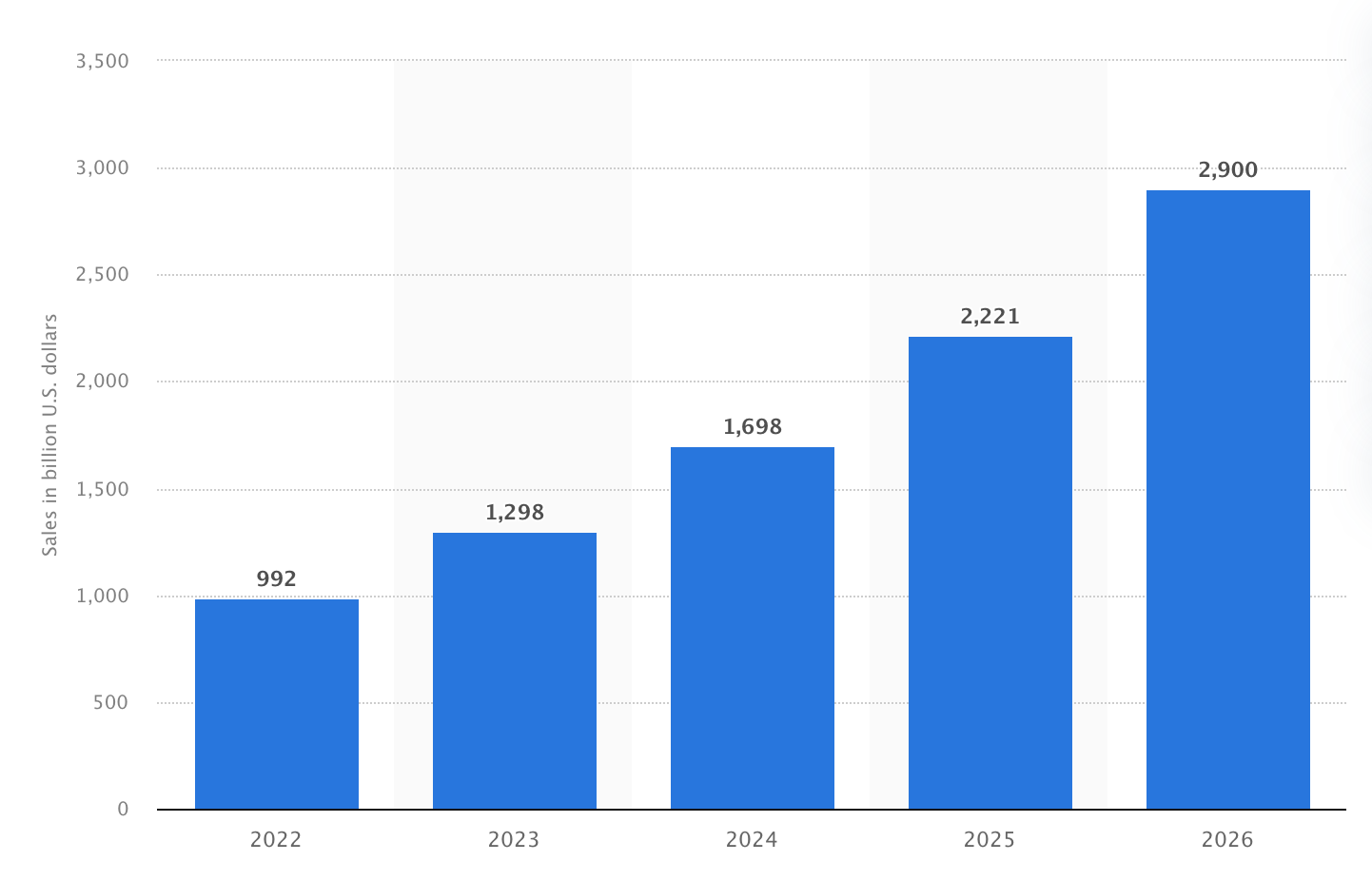
Social commerce differs from traditional social media marketing strategies where shoppers view a brand’s content and visit their website to start shopping. Instead, social platforms like Facebook Shops and Instagram Shops act as virtual storefronts.
Social commerce is booming because social media usage is. Research shows the typical social media user now spends about 15% of their waking life on social platforms, with 10% of US adults having an addiction to at least one app.
Currently, in the US, Gen Z and millennials are the most likely social network users to have made at least one purchase via a social channel.
Social commerce is a simple way to promote and sell products. For example, while scrolling on Instagram you may see a set of skin care products, tap Shop Now, add it to your shopping cart, and check out within the app.
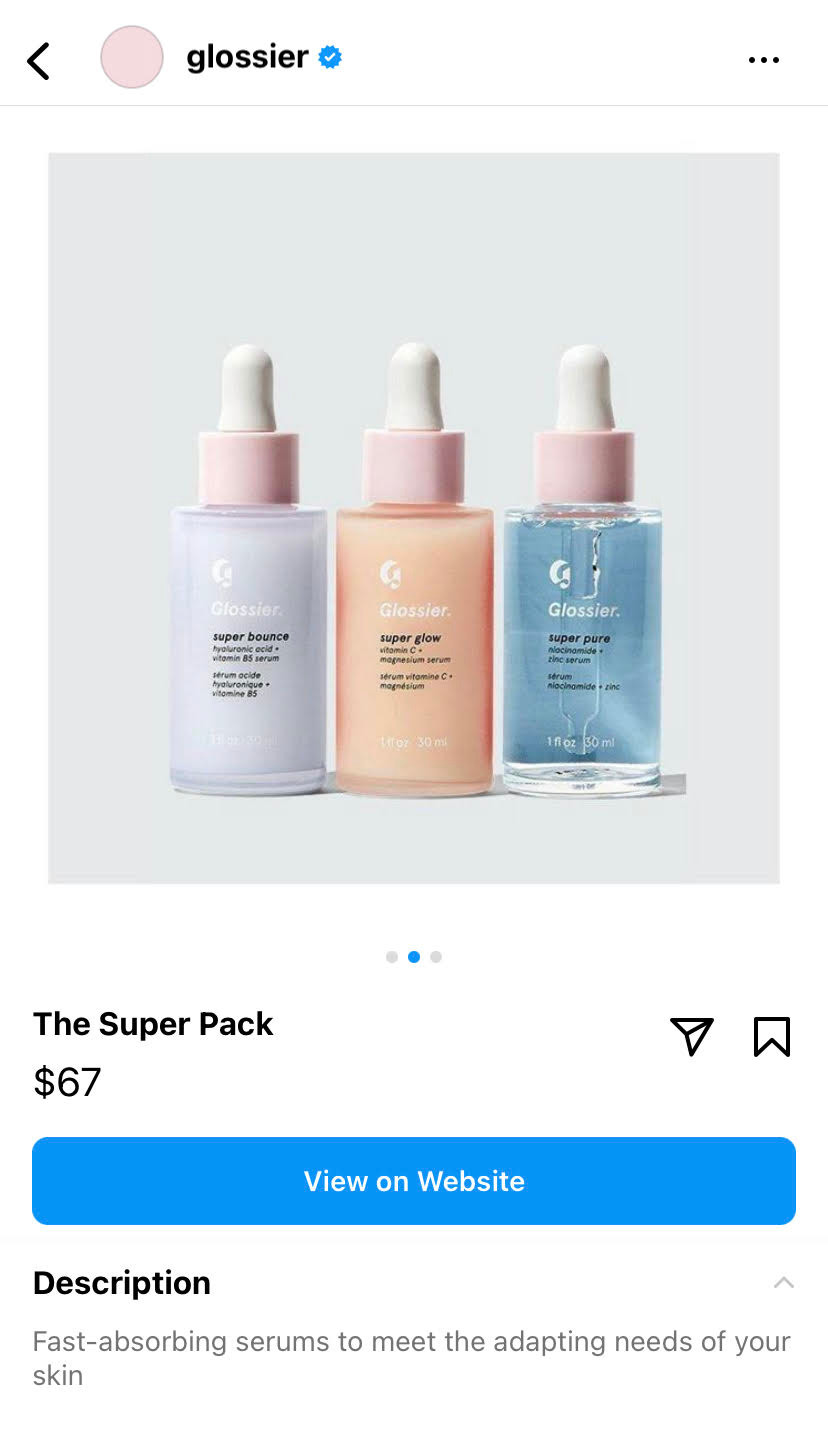
Currently, these four social media apps have built-in native social commerce features:
- TikTok
What’s the difference between social commerce and ecommerce?
Social commerce and ecommerce are not the same. Ecommerce is a shopping experience that takes place on a website or branded app. These sites are usually built on ecommerce platforms like Shopify. Consumers can access these sites on any internet-enabled device, such as a desktop, tablet, or mobile device.
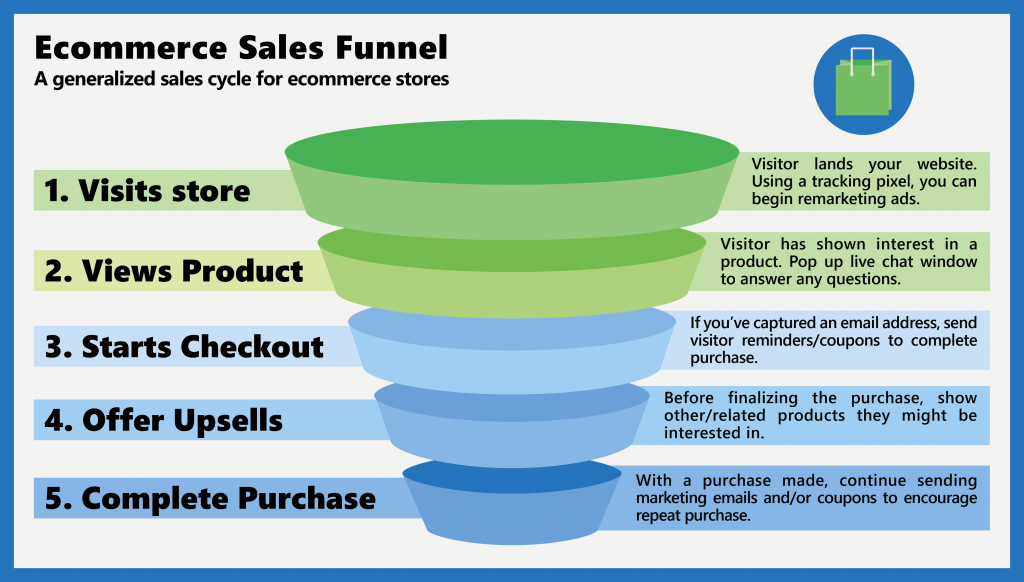
Social commerce (a subset of ecommerce) is the use of social media platforms like Facebook and Instagram to market and sell products and services. This type of selling model lets customers complete purchases without leaving social media apps.
With social commerce, brands can sell through their social media platforms. There’s no requirement to have their own ecommerce site to get set up with social media platforms’ native selling tools. But, online retailers that do have a website with an online store can benefit from directing leads to their website too.
Social commerce is sometimes confused with social selling. But social selling is the process of building relationships to later make a sale. Social selling can take place offline or online but often takes place through social media platforms.

What are the top social commerce platforms?
There are four major social platforms that currently provide native social commerce tools. As the popularity and revenue of social commerce continue to grow, more social media platforms may create virtual storefronts with Buy buttons.
1. Facebook
According to Statista, Facebook was the most popular social media platform used for purchases in 2021.
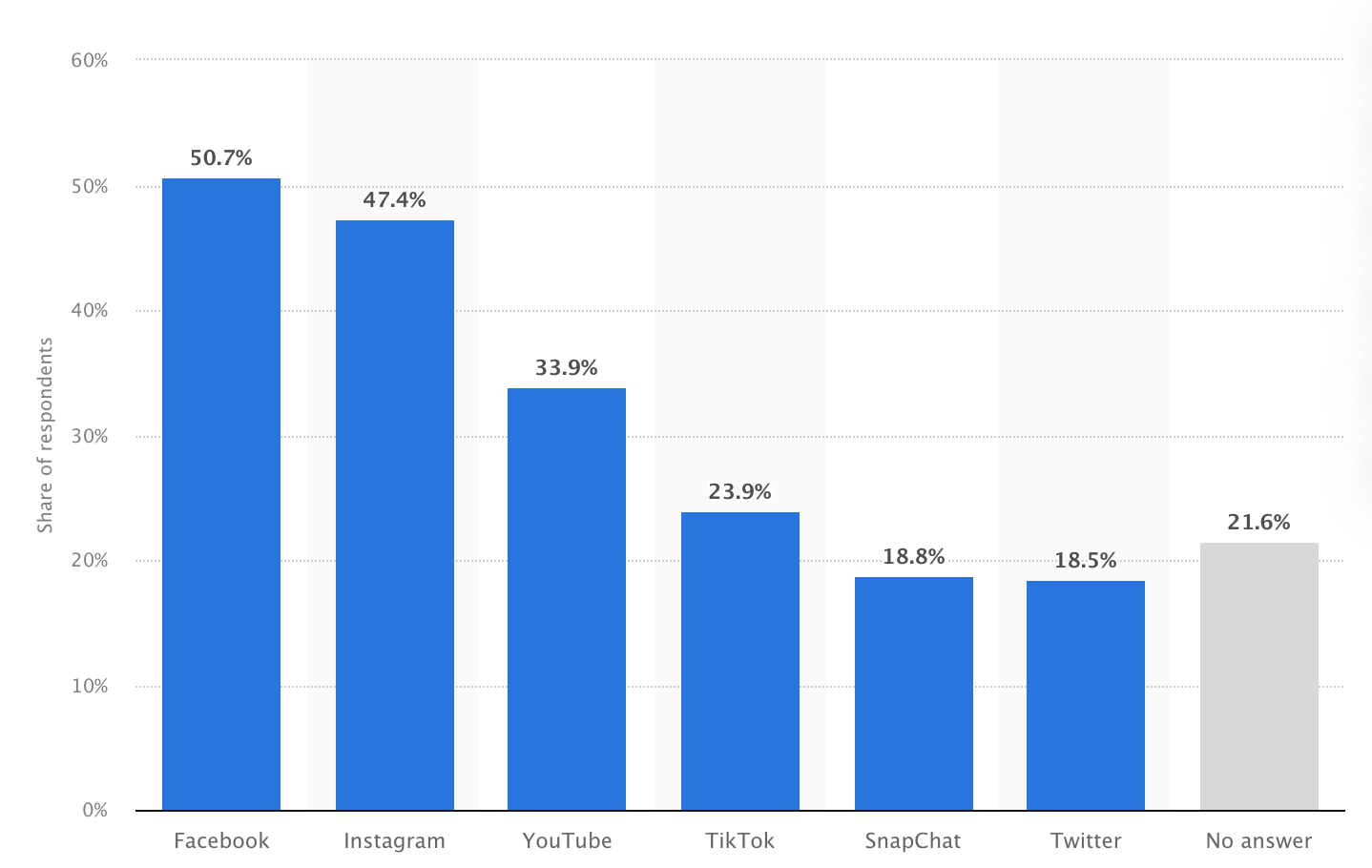
Plus according to an eMarketer survey, close to 71% of global Facebook users purchase from the platform at least some of the time.
That equates to 59.4 million buyers—many of whom you can reach by opening a Facebook shop.
For brands looking to venture into social commerce, it makes sense to start with a Facebook page. Any Facebook Business account can set up a Facebook shop, a completely customizable online storefront. Here, brands can upload their product catalog or create one from scratch.
Visitors to a brand’s Facebook profile can view available products––including sizes, color variations, and specifications. Potential customers can ask brands questions directly through Facebook Messenger. Once ready to purchase items, they can use Facebook Checkout without leaving the platform, or brands can redirect them to an online store.
Using the Shopify integration, brands can automatically sync products to Facebook and create shoppable posts and ads. This simplifies the importation process and makes it easy for merchants to bring the look and feel of their Shopify store to Facebook shops.
Brands that are new to social commerce can set up a test shop within Facebook shops, where they can add products, manage orders, and evaluate customer experience.
2. Instagram
According to Instagram, one in two people use the platform to discover new brands, products, or services. Plus, 44% of people use the platform to shop weekly. From building brand awareness to providing a better online shopping experience, Instagram is a great way for brands to reach a larger audience and sell more products.
Instagram Shops let users buy products shown in images and videos across the app. Similar to Facebook, Business accounts can showcase their products through a customizable virtual storefront. Here, brands can create curated collections of products. Each item in an Instagram Shop catalog gets its own page, including pricing, a detailed description, and any photos or videos displaying it.
There are several ways brands can use Instagram Shops to sell their products. Here are some of Instagram Shop’s top features:
- Shopping tags. These let brands tag their products in their feed posts and Stories.
- Shop tab. Here, Instagram users can browse, save, and purchase products displayed by brands or tagged by influencers.
- Ads. Businesses can create Instagram Ads with Shop tab placements too. The ad will show up with a Sponsored label and let users tap through to the storefront or complete product description.
- Shop through DMs. Customers can purchase from businesses through Instagram DMs. Shoppers can ask questions, make purchases, and later track their orders.
3. TikTok
TikTok is the new kid on the block, but its rapid growth could fool anyone into thinking it’s been a social commerce platform for longer than it has. The video-sharing platform is predicted to hit 48.8 million US users by 2025, beating Instagram’s 48.2 million, despite the latter’s six-year lead.
But TikTok users aren’t just scrolling through the app to be entertained. According to TikTok, 39% of users have discovered a product or brand on TikTok they didn’t know about before. Almost half have purchased something they saw on the app.
TikTok’s official foray into social commerce happened when it partnered with Shopify to launch in-app social shopping in 2021. Merchants with a TikTok For Business account can add shopping tabs to their brand’s profile, showcasing a virtual storefront for users to browse without the friction of exiting the app.
4. Pinterest
Pinterest is a combined search engine and social-media platform for images. Users create mood boards, pin places to travel, and, more importantly, discover new products.
More than 400 million people use the platform every month to find ideas and research products. The best part? The vast majority (97%) of Pinterest searches are unbranded. When merchants upload product listings from their online store to Pinterest, they have the ability to reach potential customers who aren’t aware of its products just yet.
Allbirds, for example, uses shoppable pins to reach customers through Pinterest. These listings are optimized both for the brand name and the product type, giving Allbirds the best shot at reaching people using Pinterest’s Shop tab to discover new products.
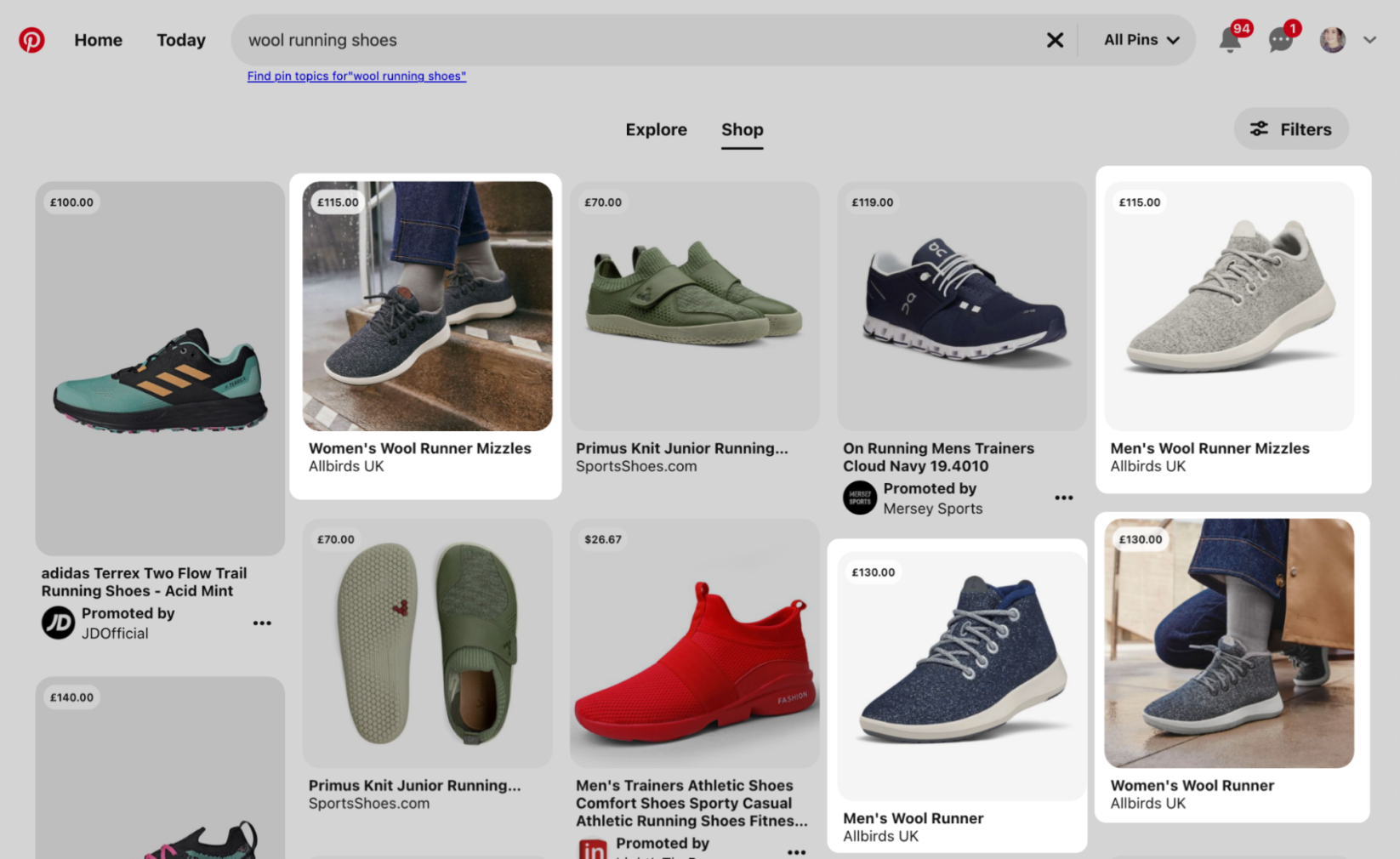
Benefits of social commerce
In the US, social commerce is predicted to be worth $79.64 billion by 2025. For retail brands interested in using social commerce tools, there’s a large piece of the pie to claim.
Other than the potential boost in ecommerce sales, using social commerce brings retail businesses plenty of other benefits too.
Here are the top five benefits of social commerce:
- Reach a larger target audience
- Frictionless shopping experience
- Gather data on your audience
- Lean into social proof
- Receive customer feedback
1. Reach a larger target audience
4.59 billion people, or 57% of the global population, currently use social media. This figure is projected to reach 5.17 billion by 2024. There’s more opportunity than ever before to reach a global audience through social media.
Plus, increasing numbers of social media users are starting to shop through social platforms. If your target audience lies in the 18-to-34 age group, they’re already scrolling and ready to shop.
In the US, Generation Z and millennials are the most likely social network users to have made at least one purchase via a social channel.

2. Frictionless shopping experience
Functionality like in-app checkout, Buy buttons, and instant messaging tools make buying through social media convenient.
Using social commerce helps eliminate unnecessary steps in the purchasing process. With extra steps in the buying process, there’s more chance of customers losing interest and abandoning purchases.
By letting users stay within the app all the way from discovery through to checkout, there’s a lower risk of shoppers dropping off.
For example, instead of redirecting a Facebook user from the app to your website, the platform has a “checkout on Facebook” option. Instead of interrupting their time on the platform, shoppers can browse products and purchase them without leaving social media.
3. Gather data on your audience
Social media platforms are a top source of customer data. This valuable data can inform future marketing campaigns and product development.
Instagram Insights provides demographic data including gender, age group, and geographical location. Using Facebook Audience Insights, marketers can gather even more in-depth data about their target audience. Demographics overview provides age and gender breakdowns, job titles, relationship statuses, and education levels. Brands can also find out about users’ interests and hobbies.
Using this data, retailers can build highly targeted ad campaigns so their products appear in front of their ideal audience. Social commerce gives brands the chance to get products in front of specific and highly targeted audiences that traditional ecommerce sites can’t replicate.
3. Lean into social proof
Eighty-nine percent of online shoppers check reviews before purchasing. People need to trust brands before they press Purchase, so they’ll look at past customer reviews, compare products, and even talk to other customers before making a decision.
Social commerce comes with integrated social proof in the form of user-generated content. Comments, likes, shares, and follows all help potential shoppers trust your brand. When customers keep interacting with and promoting your brand, other social media users are more likely to trust your brand too.
Brands can incentivize users to share content with giveaways, discount codes, or coupons. Branded hashtags that encourage users to share images or videos of them using products are another way to build social proof.
For example, DTC skin care brand Curology regularly shares customers using its products to build trust with its Instagram audience.
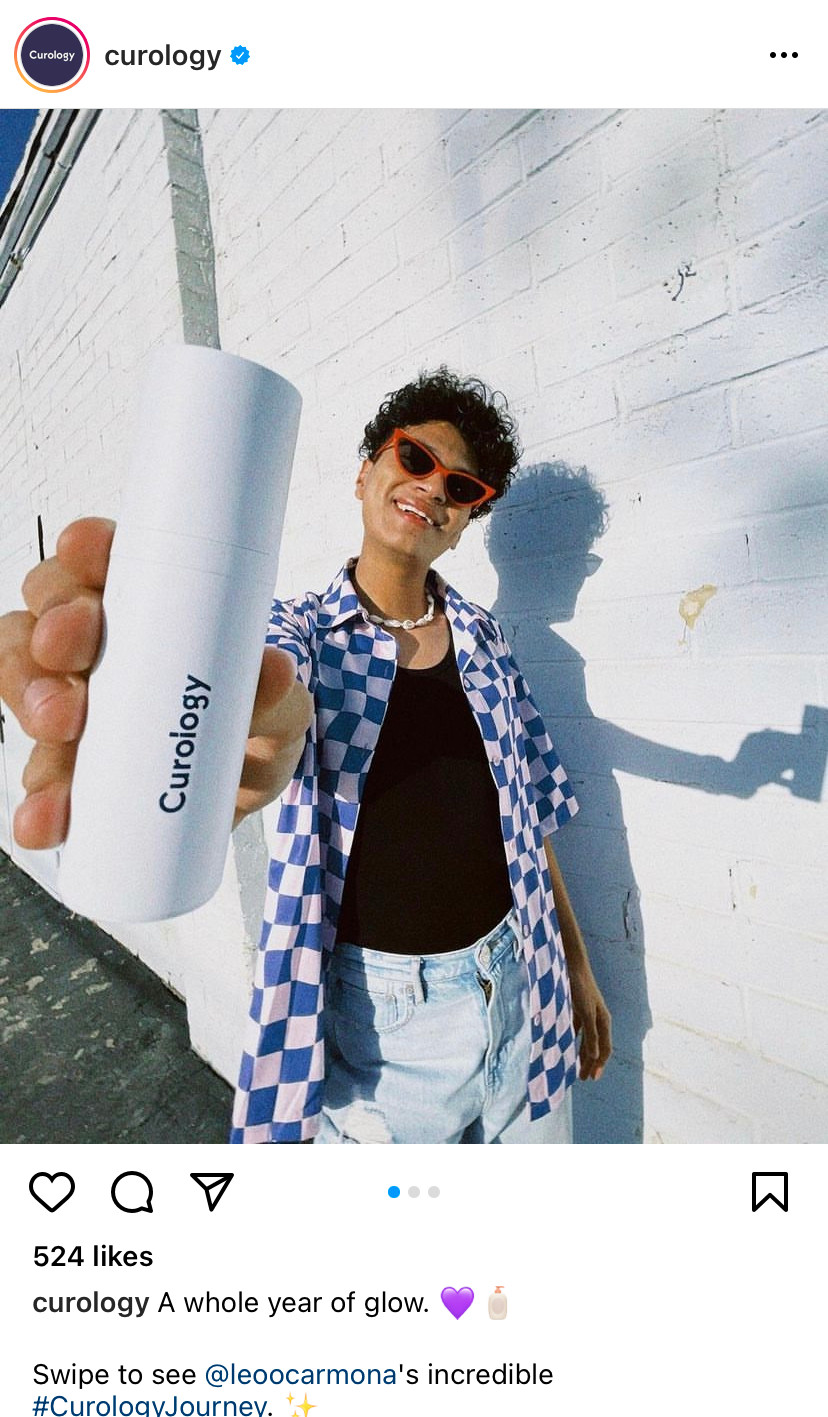
Influencer marketing also helps build trust and generate social proof. When well-known influencers showcase your products, it increases your brand’s credibility. For instance, 89% of YouTube viewers trust the recommendations YouTube creators provide.
Using YouTube Shopping, brands can pin products next to their video so viewers can like, subscribe, and buy.
4. Receive customer feedback
Social media makes it easy to interact directly with customers and get their feedback on your brand and products. Customers love to share their opinions, as it makes them feel like valued individuals. Brands can run polls, ask customers for their opinions in the comments, and chat through messenger tools.
Using this feedback, retailers can tailor their offerings to meet customer expectations. Whether that’s better customer service, more product size options, or a new clothing collection, once retailers have these insights they can take action.
Social commerce industry statistics
Social commerce is booming because social media usage is. Research shows the typical social media user now spends about 15% of their waking life on social platforms, with 10% of US adults having an addiction to at least one app.
Despite these worrying statistics, social commerce in the US isn’t as big as it is in other countries. Some 30% of internet users in the United States already make purchases directly within social platforms, but China is the clear global leader.
China’s borders house the most digital buyers in the world, and those shoppers’ purchases make up over 50% of all retail sales. Plus, according to eMarketer, almost half of internet users in the country shop on social networks. Those consumers generate more than 10 times the sales of the United States.
Global brands are learning from the social commerce strategies used by Chinese merchants. So, what can we expect to see over the coming year? Here are four trends to keep in mind if “master social commerce” is on your agenda.
88% of people would like to see more video content from brands
For most social media platforms, video content now takes priority. Take a look at the laundry list of new features released by social media giants over the past few years and you’ll notice one thing they all have in common: a love for video.
For retail brands, this preference for video content is good news too––88% of people say they’ve been convinced to buy a product or service by watching a brand’s video.
TikTok’s video-only platform dominated the social media landscape at a record-breaking time. Instagram launched Reels, a TikTok rival, to keep up.
Let’s be honest: there’s some really serious competition right now. TikTok is huge, YouTube is even bigger, and there are lots of other upstarts as well. People are looking to Instagram to be entertained, there’s stiff competition, and there’s more to do.”
—Adam Mosseri, Head of Instagram
Off the back of these changes, consumers are becoming increasingly reliant on video throughout the shopping journey.
Brands new to the video space can test the waters by incorporating product and live videos into their social commerce strategy.
Record a short clip showing one to two products in action. Film with interactivity in mind, providing clickable calls to action throughout the video that direct followers toward your social storefront. This Instagram Reel by Kylie Cosmetics, for example, tags products from its Instagram Shop:

Regardless of the video format and channel you use, remember that shoppable videos are still new to some viewers, especially those outside of Southeast Asia. Make it obvious that viewers can shop products directly through the post with captions and frequent reminders.
60% of shoppers say livestreaming improves the shopping experience
Live commerce uses social media platforms to blend livestreaming and commerce. Viewers tune into a Facebook Live (or equivalent) video, have real-time communication with a brand, and purchase items off the back of its answers.
While the US is still in its earlier stages in the US, livestream has made waves in China. China’s livestream selling market grew from $3 billion to $171 billion in three years. “If China’s experience is any guide, our analysis indicates that live-commerce-initiated sales could account for as much as 10 to 20 percent of all e-commerce by 2026,” says McKinsey & Company.
Current estimates suggest that the livestream market will be worth $35 billion in the US by 2024.

Retail businesses prepared to tap into livestream shopping can expect large rewards too––brands report live commerce conversion around the 30% mark—that’s 10 times higher than conventional commerce. Plus, they’re experiencing lower product return rates—the biggest thorn in ecommerce merchants’ sides.
Some US companies have partnerships with mainstream social media platforms to piggyback onto the trend, like Sephora’s Facebook collaboration. Others have created their own channels outside the well-established platforms. Nordstrom, for example, launched its own live shopping channel.
The power of liveshopping has not been nearly tapped yet, and we’re on the precipice. We’re just starting on that, and we are really pushing into it. We already have a Head of Live Shopping.”
—Ann McFerran, Founder and CEO, Glamnetic
43% of consumers say they’re likely to use live chat in the next year
Our Future of Commerce report found 60% of shoppers think an excellent past customer service experience is a driving factor in influencing their purchase decision. Another 58% say the ability to easily reach customer service in the channel of their choice is important to them.
However you interpret that data, one thing’s clear: shoppers are demanding easy access to the brands they’re thinking about purchasing from. Social media—a place where real-time conversations with others are actively encouraged—is the perfect facilitator.
Live chat is one feature that helps make social commerce more sociable and interactive. Customers expect to interact with brands in the same way they chat with their friends––through social apps.
“More and more shoppers are going online to connect and interact authentically with the brands they like,” says Jared Pobre, co-founder of Caldera + Lab. “And creating that genuine engagement will require more than liking, commenting on, and sharing your followers’ posts.
“Brands will also need to implement one-on-one social media experiences with prospects through conversations in private messages. These messages can range from offering discounts on new products or promotions to post-purchase customer support.
“A more personalized engagement experience will make prospective buyers and new customers feel valued and assure them that your business is there when they need you.”
If you’re not already offering live chat to social commerce customers, now’s the time. Some 43% of consumers surveyed by Shopify say they’re likely to use live chat in the next year. Miss out on those chances to connect with your customers and risk losing revenue.
In 2022, I’m expecting to see more experiments with chatbots and chat commerce. Consumers spend more when their shopping experience is personalized. AI powers chatbots on several websites that sell products or services to consumers. This technology is on an upward trajectory.”
—Jay Levitt, Founder and CEO of Lofta
Influencer marketing is set to be worth $16.4 billion in 2022
Despite fears the pandemic would slow down influencer marketing, it has only fueled further growth. Increasing numbers of social media users are choosing to monetize their content.
While half of merchants plan to work with influencers to develop co-branded products next year, the type of social media user who fits a brand’s “ideal influencer” criteria is changing.
“2021 became the era of relatability,” says Chris Vaccarino, CEO and founder of Fanjoy. “The perfect Instagram photos dissolved and Gen Z came out swinging, pushing for real people to be stars. Overly edited photos, picture-perfect lifestyles, and celebrity status took a backseat to incoming TikTok stars who are your classmates, co-workers, and family members.”
Chris expects this trend to continue throughout 2022: “We’ll continue to see TikTok dominate with normal and regular people finally breaking out of the mold and becoming people with real influence. Co-workers will quit jobs and pursue content creating full time and build real careers doing what they love.”
It’s true: Instagram influencers with fewer than 10,000 followers can charge $193 per sponsored post. No wonder 86% of young people want to make influencing a side hustle.
“Bigger brands will emerge from those creators with specific niche categories and those who have the business acumen will build actual companies from doing what they love,” Chris adds.
“Sustainability, although a big movement, will continue to push forward, and Gen Z will be super conscious about the products they’re consuming, where and how they’re made, and be more mission-focused than ever before.”
Combine influencer marketing with livestreaming and you’ve got a social commerce storm on your hands. Seven in 10 US internet users frequently watch livestreams from influencers. Some 29% of them are likely to buy recommended products off the back of one.

Social commerce trends for 2022 and 2023
Some 30% of internet users in the United States already make purchases directly within social platforms, but China is the clear global leader.
China’s borders house the most digital buyers in the world, and those shoppers’ purchases make up over 50% of all retail sales. Plus, according to eMarketer, almost half of internet users in the country shop on social networks. Those consumers generate more than 10 times the sales of the United States.
Global brands are learning from the social commerce strategies used by Chinese merchants. So, what can we expect to see over the coming year?
Here are 10 social commerce trends set to shape 2023:
People engage with more AR experiences
AR and VR are entering the mainstream. In 2022, more than 25% of the US population will use AR, and close to 20% will use VR.
In 2022, 16.6% of the US population will use AR through social networks. That figure will tick up to 19.8% by 2025.
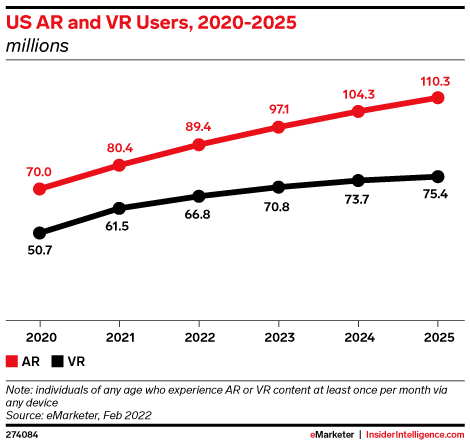
Social media is a key driver of AR usage. People often first experience AR when they use a filter or lens in Snapchat, Instagram, or TikTok. Retailers can tap into this trend by using AR filters to demonstrate their products or allow customers to try them on virtually.
For example, L’Oréal and Facebook recently announced a partnership to bring AR-fueled makeup try-ons to shopping on Instagram. Customers can go to the brand’s Instagram page, find a product, and virtually try it on before purchasing.
Sue Young, Head of Spark AR, Facebook, explains that using AR during the social commerce shopping journey has the potential to improve the customer experience.
“AR Try On is an exciting new foray within Facebook that’s already helping people shop online with more confidence,” she says. “Through this new integration with L’Oréal, shoppers can expect a more personal shopping experience from even more of the brands they love, right where they’re already finding beauty inspiration: on Instagram.”
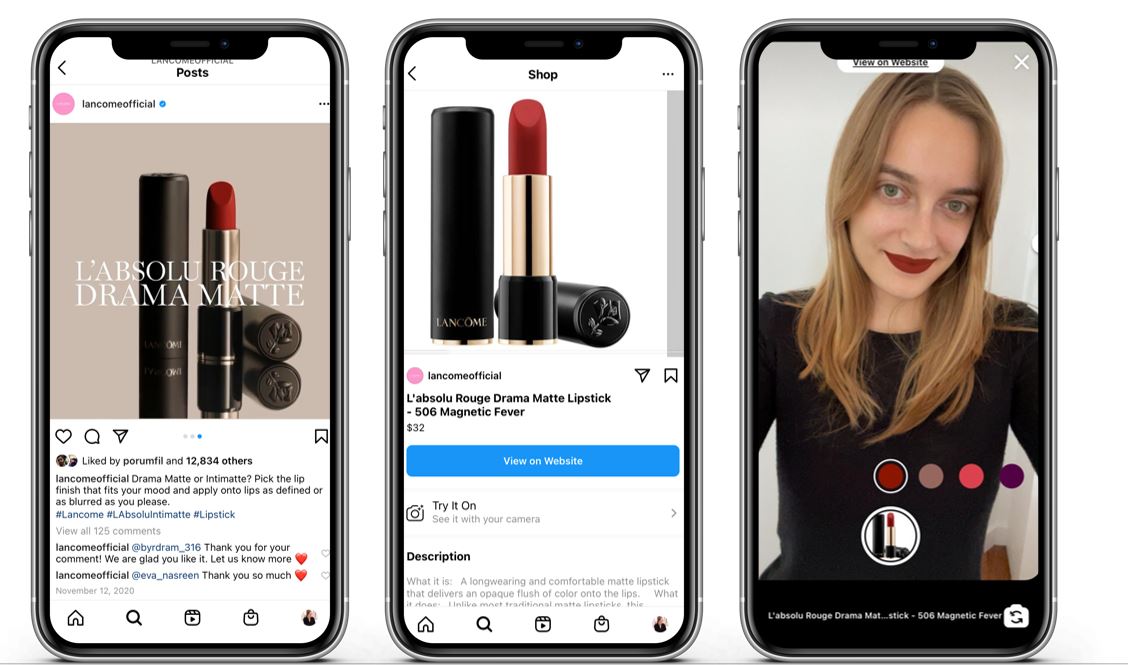
Brands can harness social media AR to help customers figure out which products they want to purchase. Instead of relying on customers going to physical stores to try on products, they can use the technology to get a feel for items at home.
More video content to showcase products in action
Eighty-eight percent of people would like to see more video content from brands. For most social media platforms, video content now takes priority. Take a look at the laundry list of new features released by social media giants over the past few years and you’ll notice one thing they all have in common: a love for video.
For retail brands, this preference for video content is good news too––88% of people say they’ve been convinced to buy a product or service by watching a brand’s video.
TikTok’s video-only platform dominated the social media landscape at a record-breaking speed. Instagram launched Reels, a TikTok rival, to keep up.
Off the back of these changes, consumers are becoming increasingly reliant on video throughout the shopping journey.

Brands new to the video space can test the waters by incorporating product and live videos into their social commerce strategy.
Regardless of the video format and channel you use, remember that shoppable videos are still new to some viewers, especially those outside of Southeast Asia. Make it obvious that viewers can shop products directly through the post with captions and frequent reminders.
Stick to one or two products per video and show them in action. Film with interactivity in mind, providing clickable calls to action throughout the video.
Brands can also take a social-first approach by creating behind-the-scenes livestreams, video consultations, and personalized product recommendations.
NFTs become a community-building tool rather than an investment
Throughout 2021, demand for non-fungible tokens (NFTs) soared. In 2022, NFTs became mainstream. But there’s growing skepticism and debate around the use of NFTs. Right now, there’s criticism surrounding their environmental impact, unstable nature, and lack of regulations. So the question is: Are NFTs losing their shine?
In May, just 2% of US adults surveyed have invested in NFTs and like them, while another 4% have invested but aren’t happy about it. The 64% majority said they have no investment or interest in these assets, up from 56% in October 2021.
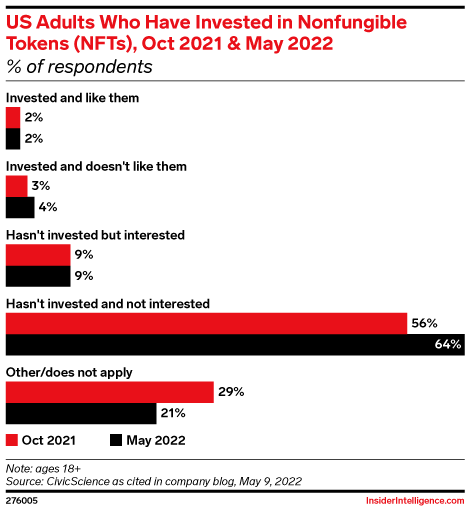
Despite the cryptocurrency market volatility and growing criticism, brands investing in social commerce should investigate how NFTs can boost their brand in the creative economy. Even if NFTs aren’t reliable financial investments, they may still carry strong benefits. Brands can use NFTs to build a sense of community, increase loyalty, and provide exclusive benefits.
For example, Californian winery Robert Mondavi launched the first wine label sold by NFT in the world. In a nod to its founding year—1966—the brand created a limited collection of 1966 bottles traceable by blockchain technology.
Each NFT of wine retails for $3,500 and is attached to a piece of generative digital art (art created by algorithms) and a porcelain magnum of 2019 Cabernet Sauvignon. NFT purchasers can also access exclusive on-site winery experiences.
NFTs incentivize potential customers to purchase by playing on a fear of missing out on one-time exclusive offers. NFTs are usually strictly limited, and once they’ve sold out, brands don’t usually generate more of the same.

Some brands are even using NFTs to support social causes they believe in. For example, in May 2022, MAC Cosmetics started selling collectible NFTs to raise funds to support charities in the fight against HIV/AIDs.

Micro-influencers to help brands build authentic reach
Despite concerns the pandemic would slow influencer marketing, it has only fueled growth as people crave relatable content. Influencer marketing is set to be worth $16.4 billion in 2022. While working with micro-influencers isn’t a new trend, it’s still relevant for 2023.
Smaller retail businesses in particular may find that working with micro-influencers makes their marketing budget go further while helping them engage with larger segments of their target audience.
The benefit of influencer marketing lies in the fact that 61% of consumers trust influencers’ recommendations—more than the 38% who trust branded (and often biased) social media content.
While big-name influencers with thousands or millions of followers may be out of reach to some growing retailers, micro-influencers usually work with brands at affordable budgets.
For instance, Instagram influencers with fewer than 10,000 followers can charge $193 per sponsored post.
Plus, micro-influencers usually have a specific audience type that makes it easier to target different demographics. To followers, these influencers are often seen to be more authentic than accounts with thousands or millions of followers.
In fact, micro-influencers often have much higher engagement rates. Data from HypeAuditor found that nano-influencers with fewer than 5,000 followers have the highest engagement rates (5%). This seems to decrease as the follower count skyrockets, until reaching celebrity level (1.6%).
Keep in mind the success of influencer marketing campaigns also depends on your target audience. Generation Z (ages 17–24) is most likely to respond to influencer marketing campaigns.
DTC cosmetics brand Glossier has a well-established influencer program where influencers receive product discounts or other non-monetary rewards in exchange for posting images and videos about Glossier products. The focus is on showcasing products influencers enjoy in a natural way.

User-generated content to build trust among shoppers
Shoppable user-generated content (UGC) can provide the social proof customers want to see before making an in-app purchase. Shoppers can’t physically experience an item when shopping online. But authentic visuals created by customers can provide a view into what a product looks like in reality. Seventy-nine percent of people say UGC highly impacts their purchasing decisions.
Often the most influential content isn’t overly staged product images but authentic user-generated images from real customers. In fact, a majority of consumers (56%) said that user-generated photos and videos are the content they most want to see from brands.
Online clothing boutique Lulus regularly posts images of real people wearing its clothes on their Instagram feed. It promotes the branded hashtag #lovelulus in its bio as a way to get customers to use it in their posts.
In this UGC example, the brand tags the user and includes the hashtag to show browsers the post was found through the hashtag.
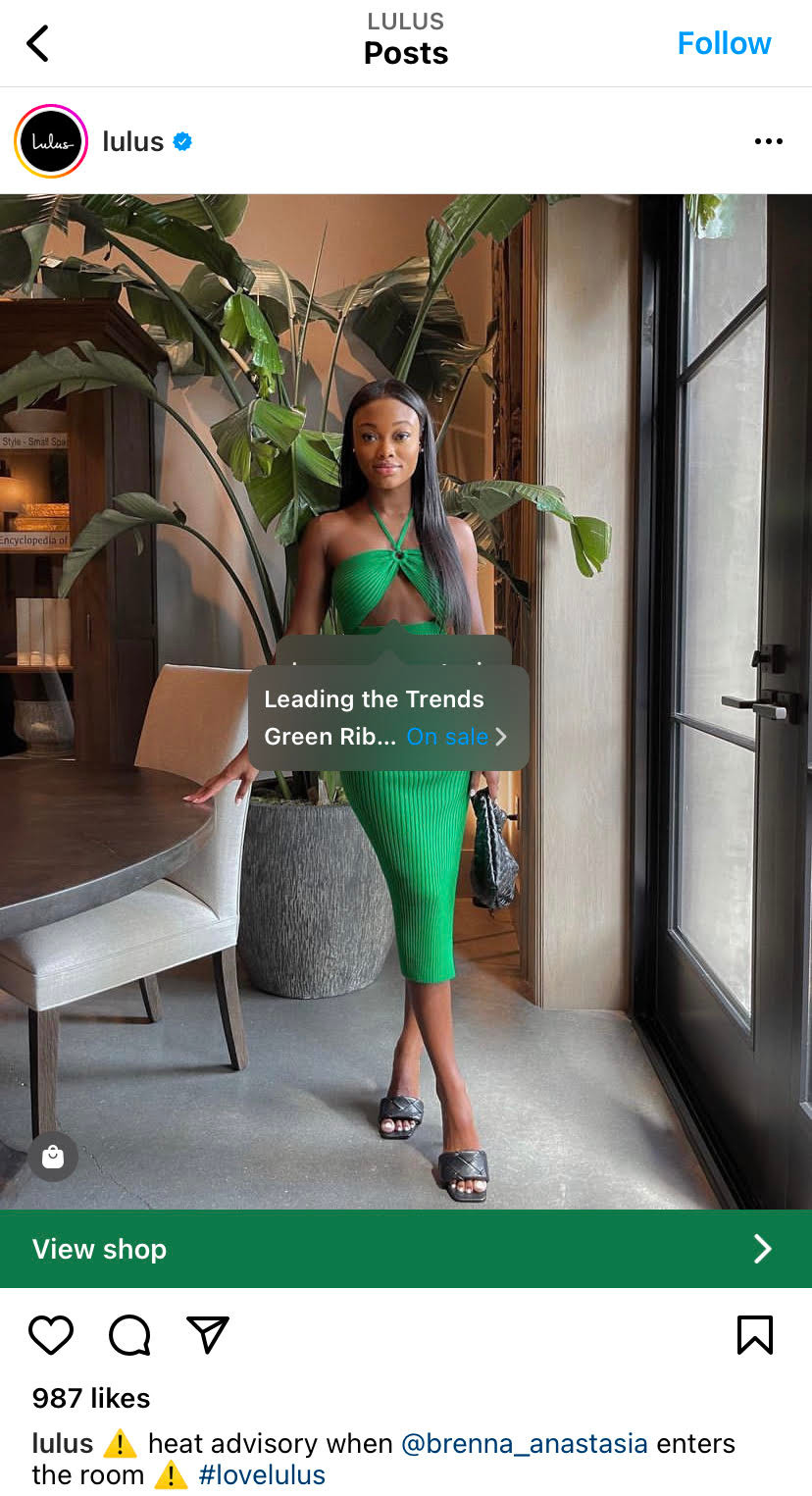
Building a hashtag campaign is a great way of encouraging customers to share images of your products in the hope of a feature in your feed. Plus, by using a branded hashtag, it’ll be easier to aggregate and choose from a large pool of UGC.
Use of AI-trained chatbots
Forty-three percent of consumers say they’re likely to use live chat in the next year. Shopify’s Future of Commerce report found 60% of shoppers think an excellent past customer service experience is a driving factor in influencing their purchase decision. Another 54% say the ability to easily reach customer service in the channel of their choice is important to them.

However you interpret that data, one thing’s clear: shoppers are demanding easy access to the brands they’re thinking about purchasing from. Social media—a place where real-time conversations with others are actively encouraged—is the perfect facilitator.
Live chat is one feature that helps make social commerce more sociable and interactive. Customers expect to interact with brands in the same way they chat with their friends: –through social apps.
“More and more shoppers are going online to connect and interact authentically with the brands they like,” says Jared Pobre, co-founder of Caldera + Lab. “And creating that genuine engagement will require more than liking, commenting on, and sharing your followers’ posts.
“Brands will also need to implement one-on-one social media experiences with prospects through conversations in private messages. These messages can range from offering discounts on new products or promotions to post-purchase customer support.
“A more personalized engagement experience will make prospective buyers and new customers feel valued and assure them that your business is there when they need you.”
If you’re not already offering live chat to social commerce customers, now’s the time. Some 43% of consumers surveyed by Shopify said they’re likely to use live chat in the next year. Miss out on those chances to connect with your customers and risk losing revenue.
I’m expecting to see more experiments with chatbots and chat commerce. Consumers spend more when their shopping experience is personalized. AI powers chatbots on several websites that sell products or services to consumers. This technology is on an upward trajectory.”
—Jay Levitt, Founder and CEO of Lofta
Frictionless shopping experiences to boost customer loyalty
Social shopping makes it more convenient for customers to shop than traditional ecommerce. Brands need to focus on providing a seamless buyers’ journey so there’s less risk of shoppers becoming frustrated and leaving.
As more commerce brands turn to social media channels to sell, brands will need to take care to create a compelling easy to navigate storefront.
Consider replicating your website experience to provide familiarity, or curating top-performing products to feature on social media.
Remove unnecessary steps and streamline your full social commerce experience. If your business is eligible, add features like Instagram Checkout or one-tap purchase so customers can more easily complete their purchase without leaving the social media platform.
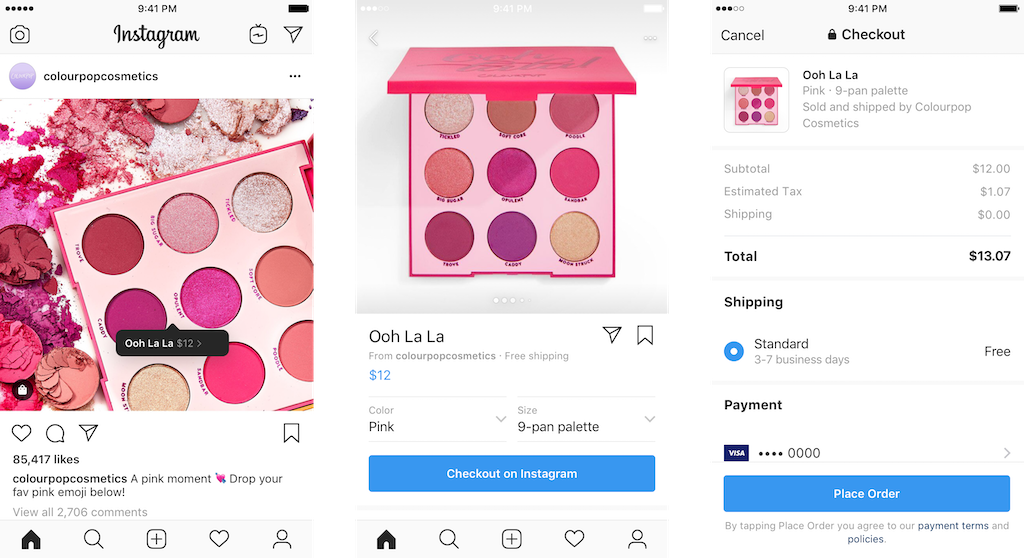
Livestreaming to increase in popularity
Sixty percent of shoppers say livestreaming improves the shopping experience. Live commerce uses social media platforms to blend livestreaming and commerce. Viewers tune into a Facebook Live (or equivalent) video, have real-time communication with a brand, and purchase items off the back of its answers.
While the US is still in its earlier stages, livestream has made waves in China. China’s livestream selling market grew from $3 billion to $171 billion in three years.
“If China’s experience is any guide, our analysis indicates that live-commerce-initiated sales could account for as much as 10 to 20 percent of all e-commerce by 2026,” says McKinsey & Company.
Current estimates suggest that the livestream market will be worth $35 billion in the US by 2024.

Retail businesses prepared to tap into livestream shopping can expect large rewards too––brands report live commerce conversion around the 30% mark—that’s 10 times higher than conventional commerce. Plus, they’re experiencing lower product return rates—the biggest thorn in ecommerce merchants’ sides.
Some US companies have partnerships with mainstream social media platforms to piggyback on the trend, like Sephora’s Facebook collaboration. Others have created their own channels outside the well-established platforms. Nordstrom, for example, launched its own live shopping channel.
The power of liveshopping has not been nearly tapped yet, and we’re on the precipice. We’re just starting on that, and we are really pushing into it. We already have a Head of Live Shopping.”
—Ann McFerran, Founder and CEO, Glamnetic
Digital avatars will become a staple in the fashion industry
Although fashion brands will continue to use influencers to market clothing, digital avatars will feature on digital fashion catwalks. Consumers may get customizable avatars so that they can more easily see how clothes and accessories will fit while online shopping.
Plus, brands can showcase different styles on multiple models and more easily layer digital clothing.
Meta’s recent launch of its Avatar Store has seen brands like Balenciaga, DressX, and Prada rush to create digital outfit collections. Users can purchase digital outfits for their avatars to express personal style online.
Meta founder Mark Zuckerberg explained in a statement how digital products will become an important part of self-identity in the metaverse: “Digital goods will be an important way to express yourself in the metaverse and a big driver of the creative economy. I’m excited to add more brands and bring this to VR soon too.”
DressX released an initial first collection to showcase the range of its designs and models:

With the increase in the use of the metaverse, fashion brands can tap into this trend by creating digital clothing and accessories that avatars can use.
Stronger integrations between ecommerce and social commerce platforms
As social commerce becomes increasingly popular, ecommerce platforms are making it easier for retailers to integrate both.
For instance, Shopify’s integration with Facebook and Instagram lets you automatically sync your Shopify product catalog to both social media platforms so you can create ads and shoppable posts. It’s also easy to bring the look and feel of your Shopify store to Facebook and Instagram Shops by grouping items together to help customers discover products.
One-tap checkout lets customers make payments without ever leaving the social app.
Shopify and TikTok have also partnered to bring product links to Shopify merchants, which can be used to tag products in organic TikTok posts. The TikTok community can choose to shop directly from the merchant’s storefront or click a tagged product in a merchant’s TikTok video, which will take them to the merchant’s online store for checkout.
A YouTube partnership lets merchants pin products next to videos so followers can like, subscribe, and buy. There’s also a live-shopping feature designed to help retailers livestream.
Rob Bridgman, founder and CEO of furniture brand Snug, explains how Shopify helped the brand get ahead of the competition.
“Shopify Plus enabled us to migrate to a more sophisticated and stable tech stack with apps that enable our virtual showrooms,” he says.
Migrating has freed up time to focus on new channels like social commerce and live selling so that we can pioneer in the furniture space as well as in the emerging marketing and technology space for retailers.”
Stay ahead of the competition and tap into social commerce trends in 2023
These social commerce trends show that the social commerce market is only set to grow in 2023. As the number of active social media users rises, platforms will continue to release new features in an attempt to capture consumer spending.
To stand out in an increasingly crowded social commerce setting, brands need to tap into these trends. Find the social media channels your target audience uses then build a strategy to interact with them there.
Social Commerce FAQs
1. What is social commerce?
Social commerce is the use of social media platforms to market and sell products and services. It lets users buy products within social platforms without exiting to another ecommerce website.
2. How does social commerce work?
Social commerce takes online shopping and fully integrates it into social media. Consumers can use their favorite social media platforms to find, browse, and purchase products, all without leaving the platform.
Social commerce relies on social media platforms’ native shopping tools like Facebook Shops. They can also use ecommerce integrations with platforms like Shopify.
3. Why is social commerce important?
Social commerce lets brands sell their products directly on social media platforms and offers a more seamless shopping experience. When customers find products they like on social media, all they need to do is click through to checkout without leaving the app. This quicker and more convenient experience lowers the risk of abandoned shopping carts.
4. What are examples of social commerce?
Any brand that promotes and sells its products through social media platforms is an example of social commerce. For example, DTC brands Glossier and Snug sell their products through Instagram Shops. Customers can view product images, read details, and make purchases without exiting the app.
5. What is the biggest social commerce site?
The biggest social commerce site is currently Facebook. It has over 2.94 billion monthly active users and offers a range of shopping features for businesses and consumers, including Facebook Marketplace, Shops, and Instagram Shopping.






